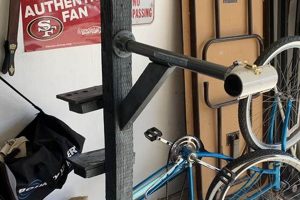The practice of constructing a platform for supporting laundry appliances, often undertaken by homeowners, involves creating a stable and elevated structure. These structures are typically made from wood, metal, or composite materials, and aim to raise the machines off the floor. As an example, a person might build a wooden frame with dimensions slightly larger than the base of their washing machine and dryer, reinforcing it with crossbeams for added stability.
Elevating these appliances offers several advantages. It can reduce strain on the back when loading and unloading laundry, provide easier access for cleaning underneath the machines, and mitigate potential damage from flooding. Historically, raising appliances has been a method employed in basements or areas prone to moisture, contributing to the longevity and optimal performance of the units.
The following sections will detail the considerations, design principles, and construction techniques involved in crafting a suitable platform for supporting washing machines and dryers, ensuring both safety and functionality.
Construction Advice for Elevated Laundry Platforms
The creation of a stable and functional elevated platform for laundry appliances requires careful planning and execution. The following points offer guidance for ensuring a successful outcome.
Tip 1: Material Selection: Employ pressure-treated lumber or metal framing for structures exposed to moisture or located in damp environments. This mitigates the risk of rot and corrosion, extending the platform’s lifespan.
Tip 2: Load Capacity Assessment: Accurately determine the combined weight of the washing machine and dryer, including a margin for dynamic loads during operation. The platform’s design must accommodate this weight safely and without deflection.
Tip 3: Vibration Dampening: Incorporate vibration-dampening pads or rubber feet beneath the appliances and between the platform and the floor. This minimizes noise transmission and prevents the platform from “walking” during operation.
Tip 4: Secure Fastening: Utilize appropriate fasteners, such as lag screws or construction adhesives, to securely connect the platform’s components. Ensure that the fasteners are compatible with the chosen materials and can withstand shear and tensile forces.
Tip 5: Leveling and Alignment: Prior to final assembly, confirm that the platform is perfectly level. Uneven surfaces can exacerbate vibrations and potentially damage the appliances. Use shims as needed to achieve a level surface.
Tip 6: Safety Considerations: When constructing the platform, adhere to all applicable building codes and safety regulations. Wear appropriate personal protective equipment, such as safety glasses and gloves.
Tip 7: Access and Maintenance: Design the platform to allow for easy access to the appliances for maintenance and repairs. Consider incorporating removable panels or providing sufficient clearance around the machines.
By adhering to these guidelines, the construction of an elevated laundry platform can be executed safely and effectively, resulting in a functional and durable structure. These considerations contribute to the long-term stability and operational efficiency of the laundry appliances.
The subsequent section will discuss specific design variations and aesthetic considerations for integrating the platform seamlessly into the laundry area.
1. Structural Integrity
Structural integrity is paramount in any load-bearing construction, and its significance is amplified in the context of creating a platform for washing machines and dryers. The appliances, when filled with water and laundry, exert substantial static and dynamic forces. A failure in structural integrity can lead to catastrophic collapse, potentially damaging the appliances, surrounding property, and causing serious injury.
- Material Strength and Selection
The choice of materials directly influences the platform’s capacity to withstand stress. Wood, steel, and composite materials possess varying degrees of tensile and compressive strength. For instance, using untreated softwood may result in deflection and eventual failure, whereas properly selected and treated hardwood or steel offers superior resistance. The selection should be based on a thorough assessment of load requirements and environmental conditions.
- Joint Construction and Fasteners
The manner in which the structural components are connected is critical. Weak or improperly executed joints constitute points of vulnerability. Examples include using insufficient screws, nails, or inadequate adhesives. Properly engineered joints, reinforced with brackets or gussets, and secured with appropriate fasteners, distribute stress evenly and prevent localized failure. The fasteners must be compatible with the materials being joined to prevent corrosion or weakening.
- Design and Load Distribution
The platform’s design must ensure that the load is distributed evenly across its support structure. Poor design, such as insufficient bracing or an inadequate number of support points, can create concentrated stress points. A well-designed platform incorporates a framework that evenly distributes the weight of the appliances, preventing excessive strain on any single component. Cross-bracing and strategically placed supports enhance stability and prevent warping or sagging.
- Dynamic Load Considerations
Washing machines, in particular, generate significant dynamic loads during their spin cycles. These forces, resulting from the machine’s vibrations, can amplify stress on the platform’s structure. Incorporating vibration-dampening materials and ensuring a rigid frame is crucial to mitigating the effects of these dynamic loads. Failure to account for dynamic loads can lead to premature fatigue and structural failure.
In essence, structural integrity is the foundation upon which a safe and functional elevated laundry platform is built. The interconnectedness of material selection, joint construction, design, and the consideration of dynamic loads ensures the platform’s ability to withstand the forces exerted by the appliances over its intended lifespan. Careful attention to these factors is essential for preventing potential accidents and ensuring the longevity of both the platform and the appliances it supports.
2. Vibration Mitigation
The significance of vibration mitigation in the construction of a platform for laundry appliances cannot be overstated. Excessive vibration not only generates noise pollution but also poses a direct threat to the structural integrity of both the platform and the appliances themselves. Effective mitigation strategies are therefore crucial for ensuring the long-term stability and operational efficiency of such a setup.
- Dampening Materials and Isolation
The introduction of dampening materials, such as rubber pads, cork sheets, or specialized anti-vibration mounts, serves to absorb and dissipate vibrational energy. These materials are strategically placed between the appliance feet and the platform surface, preventing the transmission of vibrations to the surrounding structure. In a scenario where a washing machine’s spin cycle generates substantial oscillations, these dampening elements act as a buffer, reducing the amplitude of the vibrations that reach the platform frame. Isolation is enhanced by ensuring the platform itself does not directly contact walls or other rigid structures, preventing further vibrational transfer.
- Platform Rigidity and Mass
A platform exhibiting high rigidity and substantial mass resists the tendency to vibrate. A frame constructed from thick, dense materials, such as solid hardwood or heavy-gauge steel, will inherently possess a greater resistance to deformation and oscillation. Adding ballast, such as sandbags or concrete blocks, within the platform structure further increases its mass and inertia, making it less susceptible to vibrations originating from the appliances. This approach is particularly effective in minimizing low-frequency vibrations that can be difficult to dampen through other means.
- Joint Integrity and Fastening Techniques
Loose or poorly constructed joints act as points of weakness within the platform structure, amplifying vibrations and potentially leading to premature failure. Employing robust fastening techniques, such as using high-strength bolts, construction adhesives, or welded connections, ensures that the platform frame remains tightly integrated and resistant to vibrational forces. Regular inspection and maintenance of joints are essential to identify and rectify any signs of loosening or degradation, thereby maintaining the platform’s ability to effectively mitigate vibrations.
- Appliance Leveling and Load Distribution
Ensuring that the washing machine and dryer are perfectly level and that their weight is evenly distributed across the platform surface is critical for minimizing vibrations. An unevenly loaded appliance is more prone to generate excessive vibrations during operation. Adjustable feet can be used to fine-tune the appliance’s level, ensuring that all points of contact with the platform are bearing an equal share of the weight. Distributing the load evenly across the platform minimizes stress concentrations and reduces the likelihood of vibrational amplification.
In conclusion, a multi-faceted approach to vibration mitigation is essential for achieving a stable and quiet operational environment when constructing a platform for laundry appliances. By combining the strategic use of dampening materials, robust structural design, secure fastening techniques, and careful attention to appliance leveling, the adverse effects of vibration can be significantly reduced, ensuring the longevity and performance of both the platform and the appliances it supports. These considerations are vital to the success of platform construction projects.
3. Load Distribution
Effective load distribution is a core principle in the structural design and construction of platforms intended to support washing machines and dryers. The appliances, particularly washing machines during their spin cycles, generate substantial weight and dynamic forces. Uneven distribution of this load can result in concentrated stress points within the platform, leading to premature material fatigue, structural instability, and ultimately, potential failure. A poorly designed platform may exhibit sagging, warping, or even collapse, potentially damaging the appliances and posing safety risks.
Proper load distribution is achieved through several key design elements. The platform frame must incorporate sufficient support structures, such as crossbeams and vertical supports, strategically positioned to evenly distribute the weight across the entire footprint. Material selection plays a critical role; materials with high compressive strength, such as hardwood or steel, are better suited to withstand the concentrated forces. Fastening techniques must also ensure that joints are capable of transferring the load effectively between structural members. An example would be a platform built with insufficient center support beneath a washing machine; the increased load on the unsupported section could cause bowing and eventual weakening of the wood, leading to vibration and possible collapse. Conversely, a platform with a well-braced frame and properly spaced supports distributes the load uniformly, enhancing stability and longevity.
In summary, the relationship between load distribution and the success of a platform for laundry appliances is direct and critical. A design that prioritizes uniform load distribution minimizes stress concentrations, maximizes structural integrity, and ensures the long-term safety and reliability of the platform. Neglecting this principle can lead to structural failure, appliance damage, and potential safety hazards, highlighting the practical significance of understanding and implementing sound load distribution strategies during platform construction.
4. Material Selection
The success of constructing a stable and durable platform for washing machines and dryers is intrinsically linked to the selection of appropriate materials. The weight and vibrational forces exerted by these appliances necessitate careful consideration of material properties to ensure both structural integrity and longevity. The chosen materials must be capable of withstanding sustained loads, resisting deformation, and maintaining their integrity in potentially humid environments. For example, the use of untreated softwood for the frame of a platform could result in warping, cracking, or eventual collapse under the combined weight and vibration of the appliances. This is contrasted by selecting pressure-treated lumber or steel, which exhibit superior resistance to moisture and physical stress, thereby extending the platform’s lifespan and ensuring safe operation.
The choice of fasteners also constitutes a critical aspect of material selection. The selected screws, bolts, or adhesives must be compatible with the primary construction materials and possess sufficient strength to maintain structural integrity under load. For instance, using improperly sized or corrosion-prone fasteners could lead to joint failure, compromising the platform’s stability. Furthermore, the inclusion of vibration-dampening materials, such as rubber or neoprene pads, beneath the appliances is vital for minimizing noise and preventing the transmission of vibrations to the surrounding structure. These materials act as a buffer, reducing stress on the platform’s frame and prolonging its service life.
In summary, material selection is not merely a superficial consideration but a fundamental determinant of the platform’s overall performance and safety. The proper selection and utilization of materials, coupled with appropriate construction techniques, are essential for creating a robust and reliable support structure for washing machines and dryers. Failure to prioritize this aspect can result in structural deficiencies, operational hazards, and the premature degradation of both the platform and the appliances it is intended to support.
5. Dimensional Accuracy
Dimensional accuracy is paramount in the creation of a platform for supporting laundry appliances. Precise measurements and adherence to specified dimensions directly influence the platform’s stability, functionality, and overall safety. Deviations from planned dimensions can lead to a range of problems, from appliance instability to structural failure.
- Appliance Footprint Accommodation
The platform must accurately accommodate the footprint of both the washing machine and the dryer. If the platform is too small, the appliances will not fit securely, leading to instability and potential tipping. Conversely, an excessively large platform wastes space and may not provide adequate support at critical points. Precise measurements of the appliance bases are essential for determining the platform’s optimal dimensions.
- Load-Bearing Support Placement
Internal support structures, such as crossbeams and vertical supports, must be positioned with dimensional accuracy to ensure effective load distribution. Misaligned supports can create stress concentrations, weakening the platform and increasing the risk of failure. The spacing between supports must be calculated based on the load-bearing capacity of the materials and the weight of the appliances.
- Level Surface Creation
Dimensional accuracy is crucial for creating a perfectly level platform surface. Even slight deviations from level can exacerbate vibrations and lead to appliance movement during operation. Precise measurements and adjustments are necessary to ensure that the platform is level in all directions, minimizing stress on the appliances and reducing noise levels.
- Structural Joint Alignment
The alignment of structural joints is directly dependent on dimensional accuracy. Misaligned joints weaken the platform’s frame and increase the risk of failure under load. Precise cutting and assembly techniques are essential for ensuring that all joints are square, plumb, and securely fastened.
The preceding considerations highlight the importance of dimensional accuracy in elevated laundry platforms. The combination of correct appliance fit, accurate support placement, the creation of a level surface, and well-aligned structural joints ensures a durable and safe structure. Failure to prioritize dimensional accuracy can compromise structural integrity, leading to potential appliance damage and safety concerns.
6. Safety Compliance
Safety compliance is a critical aspect of constructing elevated platforms for washing machines and dryers. Adherence to established safety standards and regulations mitigates potential hazards associated with structural integrity, electrical connectivity, and operational stability. Failure to comply with these guidelines can result in property damage, personal injury, or even fatal accidents.
- Structural Load Capacity and Building Codes
Elevated platforms must meet or exceed local building codes regarding structural load capacity. These codes specify minimum requirements for the weight-bearing capabilities of structures, ensuring they can safely support the combined weight of the appliances and any additional dynamic forces generated during operation. Non-compliance can lead to structural collapse, particularly during high-speed spin cycles. For instance, using undersized lumber or inadequate fastening techniques could result in a platform that is unable to withstand the load, leading to a hazardous situation.
- Electrical Safety Standards
Modifications to electrical systems, such as relocating outlets to accommodate the elevated appliances, must comply with relevant electrical safety codes. Improper wiring, grounding issues, or the use of non-approved electrical components can create fire hazards and pose a risk of electrocution. An example of non-compliance would be extending an existing electrical circuit without the appropriate gauge wiring or failing to use ground fault circuit interrupter (GFCI) outlets in damp locations, increasing the risk of electrical shock.
- Stability and Anti-Tip Measures
The platform’s design must incorporate features to prevent tipping or movement of the appliances, especially during operation. This may involve securing the platform to the floor or wall, using anti-vibration pads, or implementing physical restraints to prevent the appliances from shifting. Failure to implement these measures can result in the appliances moving or falling off the platform, causing damage and potential injury. An example would be constructing a platform without adequate bracing or failing to use leveling feet, leading to instability and a higher risk of tipping during the spin cycle.
- Accessibility and Ergonomic Considerations
Safety compliance extends to ensuring that the elevated platform does not create new accessibility hazards or compromise ergonomic factors. The platform should not obstruct access to other essential utilities or create tripping hazards. The height of the platform should be carefully considered to minimize strain on the back when loading and unloading laundry. Non-compliance could involve creating a platform that is too high, making it difficult or unsafe to reach the appliance controls or to lift heavy laundry items.
The integration of these safety compliance facets during the elevated laundry appliance platform construction process is critical. Prioritizing adherence to building codes, electrical standards, stability measures, and ergonomic considerations contributes to a safer and more functional laundry area. Neglecting these aspects increases the likelihood of accidents and diminishes the long-term viability of the platform.
Frequently Asked Questions Regarding Elevated Laundry Appliance Platforms
The following addresses common inquiries concerning the design, construction, and safety aspects of building a platform to raise washing machines and dryers.
Question 1: Is a permit required for constructing a platform for laundry appliances?
Local building codes dictate whether a permit is necessary. Structures exceeding certain dimensions or altering existing utilities often necessitate permits. Contacting the local building department is advisable to ensure compliance.
Question 2: What is the minimum load capacity a laundry appliance platform should possess?
The platform must support the combined weight of the washing machine and dryer when fully loaded, including water and laundry. Consulting appliance specifications is crucial for determining the maximum weight. A safety factor of at least 25% is recommended.
Question 3: How can vibration be effectively minimized in a DIY laundry appliance platform?
Employing vibration-dampening materials, such as rubber pads or anti-vibration mounts, is essential. Additionally, ensuring the platform is structurally rigid and securely fastened to the floor can further reduce vibration transmission.
Question 4: What type of materials are suitable for constructing a durable laundry appliance platform?
Pressure-treated lumber, steel, or composite materials designed for outdoor use are recommended. These materials offer resistance to moisture, rot, and structural degradation, ensuring long-term stability.
Question 5: How should electrical connections be handled when installing an elevated laundry appliance platform?
All electrical work must comply with local electrical codes. Employing a qualified electrician is strongly recommended to ensure safe and proper wiring, grounding, and outlet installation.
Question 6: What safety precautions should be observed during the construction of a laundry appliance platform?
Wearing appropriate personal protective equipment, such as safety glasses and gloves, is essential. Ensuring the work area is clear of hazards and following proper construction techniques minimizes the risk of injury.
In summary, careful planning, adherence to safety guidelines, and the use of appropriate materials are crucial for creating a functional and safe elevated laundry appliance platform.
The subsequent section will address aesthetic considerations and integration strategies for incorporating the platform into the laundry area.
Concluding Remarks
The foregoing discussion has thoroughly examined the various facets involved in constructing a platform for laundry appliances, frequently referred to as a washer and dryer stand diy project. From structural integrity and vibration mitigation to material selection and safety compliance, the successful execution of such a project demands meticulous planning and diligent implementation. The interplay of these factors directly affects the long-term stability, functionality, and safety of the resulting structure.
Given the inherent risks and complexities associated with load-bearing construction and electrical modifications, careful consideration of one’s expertise is essential. While the appeal of a washer and dryer stand diy project lies in its potential for cost savings and customization, prioritizing safety and adherence to established codes remains paramount. A professional assessment may be warranted to ensure the longevity and safe operation of laundry appliances and the structural integrity of the surrounding environment.







